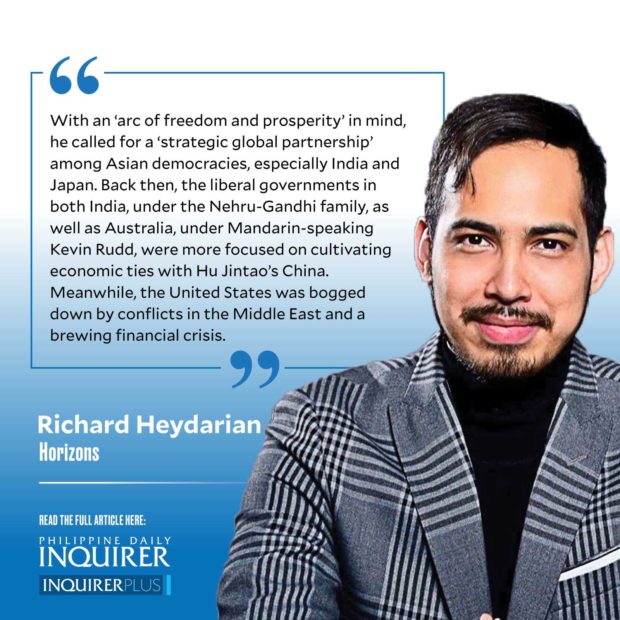Shinzo Abe: Architect of the Indo-Pacific era
In an iconic speech before the Indian parliament in 2007, then youthful Japanese leader Shinzo Abe, envisioned the emergence of a “broader Asia” amid “the confluence of the two seas of the Indian and Pacific Oceans.” Ushering in the “Indo-Pacific” paradigm, Abe, then serving his first stint as Japan’s prime minister, believed “that it is imperative that the democratic nations located at opposite edges of these seas deepen the friendship among their citizens at every possible level.”
With an “arc of freedom and prosperity” in mind, he called for a “strategic global partnership” among Asian democracies, especially India and Japan. Back then, the liberal governments in both India, under the Nehru-Gandhi family, as well as Australia, under Mandarin-speaking Kevin Rudd, were more focused on cultivating economic ties with Hu Jintao’s China. Meanwhile, the United States was bogged down by conflicts in the Middle East and a brewing financial crisis.
Article continues after this advertisementOn his part, Abe, still struggling to find his footing under former prime minister Junichiro Koizumi’s shadow, didn’t last long at the helm of Japan’s government. But the temporary setback served as a setup for a big comeback only a few years later, when his party, the Liberal Democratic Party, secured a landslide victory in the 2012 elections.
In his second act in politics, Abe came back stronger than ever, introducing a set of structural economic reforms, dubbed “Abenomics,” in order to reflate Japan’s stagnating economy and rigid labor markets. He also sought to transform his country into a major player in global geopolitics.
Throughout the 2010s, Abe wasted no time to realize his vision. On one hand, he welcomed the revision of US-Japan bilateral Defense Guidelines in 2015 in order to give Tokyo greater operational freedom. Over the succeeding years, Abe also pushed for a historic increase in Japan’s defense spending in order to transform the Self Defense Forces into a modern and capable force amid a rising China.
Article continues after this advertisementMeanwhile, he pushed for a “democratic security diamond” in the Indo-Pacific, thus tirelessly reviving the temporarily defunct Quadrilateral Security Dialogue among Japan, India, Australia, and the United States. Soon, like-minded nationalist governments in Washington, New Delhi, and Canberra embraced Abe’s Sino-skeptic geopolitical doctrine, which emphasized a “free and open order” across the Indo-Pacific.
Abe was also a reliable friend to smaller powers in the region, especially in Southeast Asia. Under his watch, Japan ($367 billion) trounced China ($255 billion) as the single largest source of public infrastructure investment in Southeast Asia. Japan also provided coast guard vessels as well as surveillance aircraft to countries such as the Philippines amid the South China Sea disputes with China. From presidents Benigno Aquino III to Rodrigo Duterte, Abe’s Japan remained the Philippines’ most comprehensive ally.
At home and abroad, Abe’s reforms proved controversial, and some critics accused him of historical revisionism. Last week, one of his detractors, a former military officer, fatally shot the former prime minister during a campaign rally. Despite its image as a peaceful nation, Japan actually has a tragic history of political violence: Between 1921 and 1932, prime ministers Takashi Hara, Osachi Hamaguchi, and Tsuyoshi Inukai were assassinated, paving the way for a militaristic regime that would terrorize much of East Asia.
Following Japan’s World War II defeat, America imposed a “pacifist” constitution, which effectively proscribed the country from projecting military power overseas. Unlike Germany, however, Japan never fully came to terms with its World War II history.
In many ways, Abe sought to emulate his grandfather, former prime minister Nobusuke Kishi, who tirelessly pushed for a more independent and self-reliant Japan in the late-1950s and barely survived an assassination attempt in 1960. Following Abe’s shocking assassination, his allies have managed to secure a supermajority in the country’s legislature (Diet) on the back of a wave of public sympathy.
Soon, Abe’s heirs may press ahead with amending the country’s constitution, especially Article 9, which proscribes the country from projecting military power beyond immediate borders. It remains to be seen if majority of Japanese voters will approve the move in any prospective referendum. But what’s clear is that Abe will go down in history as one of the consequential leaders of the early 21st century and the de facto architect of the “Indo-Pacific” geopolitical paradigm.
rheydarian@inquirer.com.ph

















